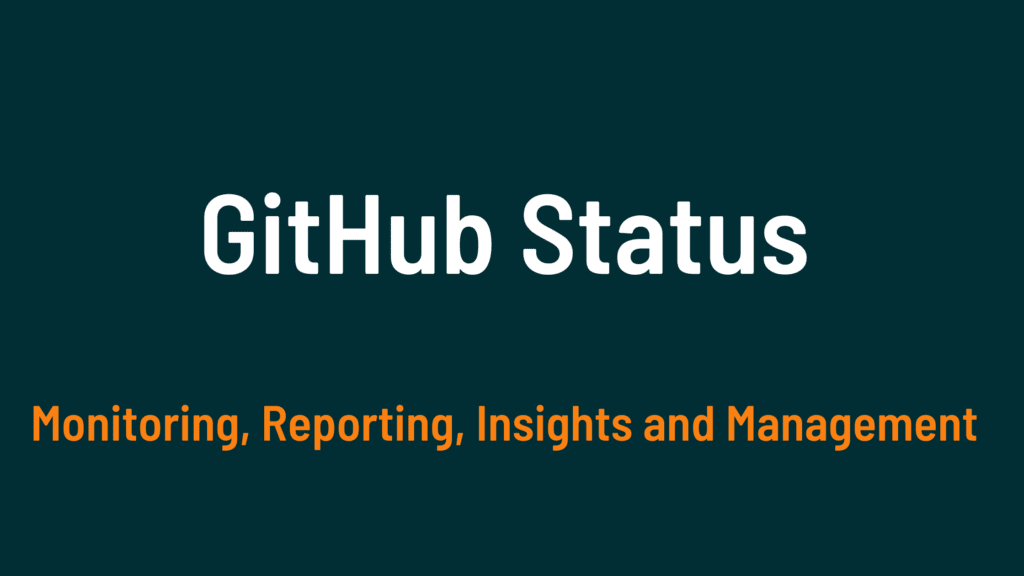
Introduction to GitHub Status and Why It’s Crucial for Development Teams
In the realm of modern software development, GitHub has emerged as a cornerstone platform for collaboration, version control, and project management. With its widespread adoption, ensuring the availability and reliability of GitHub services is paramount for development teams worldwide. This is where GitHub Status comes into play, offering real-time insights into service availability, uptime, and performance metrics.
GitHub Status is a service provided by GitHub that enables users to monitor the operational status of its platform. It provides continuous updates on service health, uptime, and any incidents that may affect the availability of GitHub’s services. For development teams reliant on GitHub for their projects, having access to real-time status updates is indispensable for ensuring seamless workflow and minimizing disruptions.
The Importance of Real-Time Monitoring
Effective monitoring of GitHub’s service status is crucial for development teams to maintain productivity and reliability. By implementing real-time monitoring solutions, teams can proactively identify and address any issues that may arise, thus minimizing downtime and optimizing service availability.
Service health checks play a vital role in real-time monitoring, allowing teams to assess the overall health and performance of GitHub’s services. By continuously monitoring key indicators such as response times, error rates, and server status, teams can promptly detect and resolve any issues before they escalate.
Additionally, real-time status updates provide development teams with timely information about any incidents or outages affecting GitHub services. This enables teams to quickly respond to and mitigate the impact of such incidents, ensuring minimal disruption to their development workflows.
Common Metrics and Indicators to Track for Effective GitHub Status Management
When it comes to managing GitHub status effectively, tracking the right metrics and indicators is essential. Some common metrics to track include:
- GitHub Performance Metrics: Metrics such as response time, latency, and throughput provide insights into the performance of GitHub’s services. By monitoring these metrics, teams can identify performance bottlenecks and optimize their workflows accordingly.
- Service Availability Indicators: Monitoring indicators such as uptime percentage and downtime duration helps teams assess the overall availability of GitHub’s services. By tracking these indicators, teams can ensure that GitHub services are consistently accessible to users.
- Incident Response Time Tracking: Tracking the time taken to respond to and resolve incidents is crucial for minimizing downtime and optimizing service availability. By monitoring incident response times, teams can identify areas for improvement and streamline their incident response processes.
Best Practices for Communicating GitHub Status Updates Internally and Externally
Effective communication is key when it comes to managing GitHub status updates both internally and externally. Some best practices for communicating GitHub status updates include:
- Establishing Clear Communication Protocols: Define clear communication protocols for notifying team members about GitHub status updates and incidents. This ensures that everyone is aware of any issues affecting GitHub services and can take appropriate action.
- Implementing Transparent Reporting Practices: Foster transparency in reporting GitHub status updates by providing detailed information about incidents, their impact, and the steps being taken to resolve them. This helps build trust with users and stakeholders and demonstrates a commitment to service reliability.
- Streamlining Incident Response Procedures: Develop standardized incident response procedures to ensure swift and effective resolution of GitHub service incidents. This includes defining roles and responsibilities, establishing escalation paths, and implementing post-incident review processes to identify lessons learned.
Tools and Technologies for Automating GitHub Status Monitoring and Reporting
Automating GitHub status monitoring and reporting can greatly streamline the process and ensure timely updates. Some tools and technologies for automating GitHub status monitoring include:
- Monitoring Tools for GitHub Status: Utilize monitoring tools such as Prometheus, Grafana, and Datadog to continuously monitor GitHub’s service status and performance metrics. These tools provide real-time insights into service health and enable proactive incident management.
- Automated Alert Systems: Implement automated alert systems to notify team members about any changes or incidents affecting GitHub services. This ensures that teams can respond promptly to emerging issues and minimize downtime.
- Service Status Dashboards Integration: Integrate GitHub status dashboards with existing monitoring and collaboration tools such as Slack, Microsoft Teams, or email. This provides centralized visibility into GitHub service status and facilitates seamless communication among team members.
Conclusion: Leveraging GitHub Status Insights to Enhance Development Processes and User Experience
In conclusion, GitHub Status monitoring plays a critical role in ensuring the availability, reliability, and performance of GitHub services for development teams. By implementing real-time monitoring solutions, tracking key metrics and indicators, and adopting best practices for communication and incident response, teams can optimize their development workflows and enhance the user experience.
By leveraging GitHub status insights, development teams can minimize downtime, streamline incident management, and ultimately deliver better software products to their users. With the right tools, technologies, and practices in place, GitHub status monitoring becomes a cornerstone of successful software development processes.